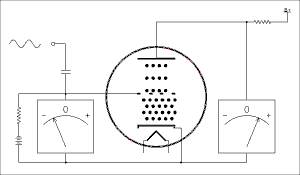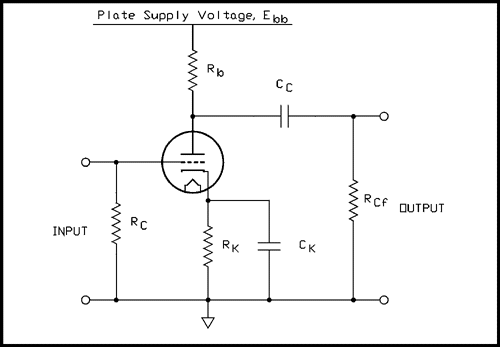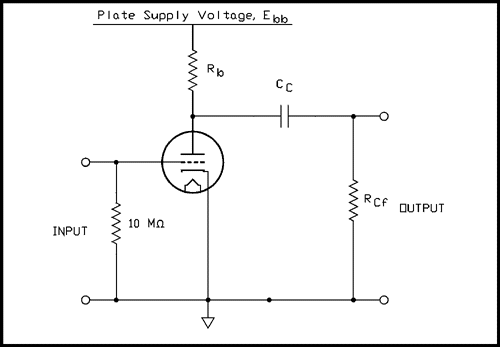
For a verbal description click here.
Figure 1 (a) filament type triode and (b) heater type triode.
Electrical Fundamentals.
The tri part of triode means 3. There are three elements in a triode, the cathode, grid, and plate or anode. If we write an ode to tri we have a 3 element tube. The heater doesn't count since it doesn't take part in the operation, it just provides the heat.
Vacuum Triodes.history.
In the United States Lee De Forest is generally credited with inventing the triode. His claim is under considerable dispute particularly in the United Kingdom. Since I wasn't there I don't know what happened but I have my suspicions. Court records of a case of De Forest versus Armstrong make it clear that De Forest didn't really understand the operation of the tube. That doesn't prove that he didn't invent it, maybe he stumbled onto it by accident. Maybe he ripped off someone else. Even though it all happened barely 100 years ago the mists of history have already settled over the facts and likely we will never know. We have the three element tube even if we aren't quite sure who to thank for it.How it is made.
Photographs of the early Audions show a big spherical bulb with a filament like that in Edison's light bulb. Next to the filament is a grid which looks like hardware cloth (a very course window screen) and a flat plate. Modern triodes are usually cylindrical in construction with the filament or heater/cathode at the center, the grid surrounding it and the plate surrounding all as shown in Figure 1 below.

For a verbal description click here.
Figure 1 (a) filament type triode and (b) heater type triode.
In these cylindrical tubes the grid takes the form of a helix, like a cork screw or spring. If you happen to have a 6AS7G or 6080WA in your tube collection you can see this construction. The plate instead of being continuous has an opening that runs the length of the cylinder and the shiny grid is clearly visible. There is a 9 pin miniature tube with the same construction but I don't know its number. I saw it once while looking for another tube and I didn't write it down.How it works.
I've made that joke too many times already. Electrons are emitted from the cathode exactly the same as in a diode. They collect in a space charge around the cathode and protect it from heavy positive ions that could do serious damage. In normal operation the grid is made negative with respect to the cathode and never goes positive. (Except in radio transmitters). The grid does not attract electrons and because its wires are very thin, in modern tubes, few electrons run into it by accident. The electric field of the grid repels the negatively charged electrons and limits the number that can pass through to the plate. If the grid is made negative enough no electrons at all can get through. As the grid is made less negative it lets more and more electrons through. Figure 2 below shows this by animation.

For a verbal description click here.
Figure 2 Animation showing the operation of a triode vacuum tube.
Although the heater connections are not shown it is assumed they are connected to the proper source of voltage for the heater. As the input signal swings positive the grid becomes less negative. This allows more electrons to get through to the plate which is an increase in plate current. The voltage drop across the plate resistor becomes greater and because the B+ end of the resistor is at a fixed voltage the plate end becomes less positive. You can see right off that as the grid voltage goes up the plate voltage goes down. This is the nature of this type of amplifier circuit. When the input signal swings negative the more negative grid cuts down the number of electrons getting through and the plate current is reduced. This causes the drop across the plate resistor to decrease and the plate voltage gets closer to the B+ voltage, higher. Neither the grid voltage nor the plate voltage gets all the way to zero. If it should the amount of distortion would be very high.Practical circuit.
I know the animation is fascinating but do your best to tear yourself away from it. Very early battery powered radios had a C battery that provided bias to the grids of the tubes. (The A battery operated the filaments and the B battery provided the B+, hence the name). The advent of heater tubes permitted a different way of getting the grid bias voltage.Cathode bias.
A cathode biased stage is sometimes known as self biased. The bias voltage does not have to be externally supplied but is developed in the cathode circuit of the tube or to think of it another way by the tube itself.Let's assume that a tube needs the grid to be at -2 volts. That means that the cathode is at zero volts and the grid is at -2 volts. Now suppose we add 2 volts to both values. The grid voltage becomes 0 volts and the cathode voltage becomes +2 volts. The grid is still -2 volts away from the cathode which is required. Think about it. Let your left hand be the grid voltage and your right hand be the cathode voltage. Place your right hand even with the table top at the edge (zero inches) and your left hand 2 inches below your right (-2 inches). Your left hand is below your right hand. Now move both hands up 2 inches. Your left hand is now even with the top of the table (zero inches) and your right hand is 2 inches above it (+2 inches). Your left hand is still 2 inches below your right hand.
To place the cathode of a triode a small number of volts positive you place a resistor in the cathode circuit as shown in Figure 3 below.

For a verbal description click here.
Figure 3 A cathode biased resistance coupled amplifier stage.
Once again the heater connections are assumed. The notation used here is consistent with the resistance coupled amplifier charts found in all tube manuals. Rc is the grid resistor, why not Rg? I guess it's a throw back to the C battery. RK and CK are the cathode resistor and capacitor. Yes, they knew that cathode begins with a C but C was already used. Rb is the plate resistor, another throw back to the B battery. Why Ebb instead of B+? Who knows. Cc is the coupling cap and Rcf is the grid resistor of the following tube.The positive voltage on the cathode is developed by the cathode current flowing through the cathode resistor. The tube, RK, and Rb constitute a simple series circuit. The grid does not take or give any appreciable current.
The capacitor in the cathode circuit is to keep the DC voltage constant. Without this cap the voltage can vary and reduce the gain of the amplifier. This gain reduction is accompanied by a reduction of distortion so in hi-fi circuits the cap is often omitted. More about this later.
Zero Bias.
An amplifier stage in which the cathode is grounded and there is no external source of bias is called a zero bias amplifier. The bias isn't really zero because the action of the tube will develop a small amount of bias. This is sometimes called contact bias because it is generated by electrons coming in contact with the grid.The grid wires are thin and very few electrons strike them but there are billions of them passing by so even a small percentage is still a very large number. Electrons that strike the grid stick to it and give it a negative charge. If the grid resistor is made very large, say 10 meg ohms, the voltage on the grid will be almost a volt. Now, if the tube has been designed so this voltage is the optimum grid voltage, and some have been, the parts count of the amplifier stage can be reduced by two. A zero biased amplifier is shown in Figure 4 below.

For a verbal description click here.
Figure 4 A zero biased resistance coupled amplifier stage.
This circuit is most commonly used in All American 5 radios but is occasionally seen in hi-fi equipment.Designing triode amplifier stages.
Probably the easiest way to design a resistance coupled triode amplifier is to use the resistance coupled amplifier charts found in most tube manuals. If you don't have one you can pick one up on eBay. At any given time there are several for sail and they usually don't cost an arm and a leg. Don't go for one from the 20s, 30s, 40s, or even the 50s. They might leave you a few limbs short. Manuals from the 1960s are usually available and go for $10 to $30. The values found in these charts have been arrived at experimentally rather than by calculation. When it comes to tubes that's often the best way. That said there are calculations that can be made and they do pretty well at predicting the gain but they don't say anything about distortion.Another page on this site gives some of this same information but from a slightly different point of view. Although I wrote it I did so about a year and a half before writing the current page. If you are having trouble understanding the material a different wording and different metaphor may help. See Resistance Coupled Amplifiers, A Basic Building Block.
Small Signal Calculations.
The small signal calculations are based on the small signal model of a vacuum tube. The triode small signal model is shown in Figure 5 below.

For a verbal description click here.
Figure 5 Small Signal Model of a Triode.
In science and engineering a model is something that represents a real system. It helps people working in the field to visualize the system more easily and make calculations based on the model that will predict the behavior of the real system. The triode tube with its resistors and power supply form a system and can be modeled.As the figure above shows the model consists of a voltage source in series with a resistor. The resistor is symbolized with a lower case r because it is not a real resistor but a part of the model. The Greek letter mu stands for the amplification factor and rp for the plate resistance. These values can be looked up in a tube manual. The voltage gain of a triode amplifier is given by the equation.
Av = mu Rbc / (Rbc + rp) Where Rbc is the parallel combination of Rb and Rcf as follows.Rbc = Rb Rcf / (Rb + Rcf) Example 4.1
A 12AX7 has a plate load resistor, Rb, of 220 k ohms and the grid resistor of the following stage, Rcf, is 470 k ohms. Tube manual data on the 12AX7 gives Amplification factor = 100 and plate resistance = 80 k ohms. What is the gain of this 12AX7 amplifierSolution
Example 4.2
A triode tube is to be used as a single ended low power amplifier. The output transformer has a primary impedance of 3000 ohms. Think of Rb being 3 k ohms and Rcf as not present. Which of the following tubes will give the greatest voltage gain?12AT7, Amplification Factor = 60, Plate Resistance = 10900
12AU7, Amplification Factor = 17, Plate Resistance = 7700
12AV7, Amplification Factor = 41, Plate Resistance = 4800
12AX7, Amplification Factor = 100, Plate Resistance = 80000
Solution
Removing the Cathode Bypass Capacitor.
If the cathode bypass capacitor is left out of the circuit, as shown in Figure 6 below, several things about the amplifier will change. The two most important are a reduction of gain and a reduction of distortion. The former is not good by itself but the latter is so good that it is worth the lost gain.

For a verbal description click here.
Figure 6 A resistance coupled amplifier stage with unbypassed cathode resistor.
If the cathode bypass capacitor is left off the gain equation becomes.Av = mu Rbc / (rp + Rbc + Rk (mu + 1)) Where mu is the amplification factor of the tube, rp is the plate resistance Rk is the cathode resistor and Rbc is the parallel combination of Rb and Rcf.Example 4.3
A 12AX7 which is without a cathode bypass capacitor has a plate load resistor, Rb, of 220 k ohms, a cathode resistor, Rk, of 3300 ohms, and the grid resistor of the following stage, Rcf, is 470 k ohms. Tube manual data on the 12AX7 gives Amplification factor = 100 and plate resistance = 80 k ohms. What is the gain of this 12AX7 amplifier
This page last updated March 4, 2004.
Home